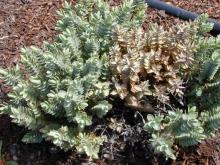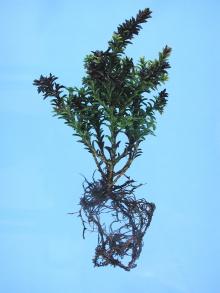Cause There have been several organisms associated with root rots and resulting branch diebacks in Oregon including Phytophthora sp., Macrophomina phaseolina (Charcoal rot) and Fusarium oxysporum. Both Phytophthora and Fusarium are favored by excessively wet soils but Phytophthora is favored by cool soils conditions while Fusarium is favored by warm soil. Phytophthora species require free moisture for infection.
Charcoal rot also is favored by warm but dry soils. The pathogen becomes active once soil temperatures are above 60°F. However, it is most active at warmer temperatures between 82-90°F. Disease may be worse in sandy, well-drained soils. Symptoms often intensify during hot summer weather and are exacerbated by drought. The fungus can survive for years in the soil as tiny, black microsclerotia. When roots of a host plant grow nearby, the microsclerotia germinate, and then infect and kill the roots. Infected roots quickly lose their ability to transport water and nutrients, which leads to aboveground symptoms of nutrient deficiency (yellowing or stunting) and water stress (wilting).
Symptoms Root rots are usually first noticed by the flagging of individual stems, often in mid-summer. Leaves on these stems turn yellow then brown. Entire sections or sides of the shrub may become affected quite rapidly, looking almost as though it were burned. Plants may be stunted. Roots below affected branches are rotted. The entire plant may die, or it may persist for months in this state.
Plants with charcoal rot have one or two stems per plant with leaves that begin to turn yellow and wilt. As the symptoms progress, the tips of the branches droop and eventually the entire branch dies, turning brown and brittle. On larger plants, the disease may progress slowly, sporadically taking out a branch or two over several years. On smaller, younger plants (less than 3 years old), however, the disease can be quite rapid where the entire plant appears to dry up and die within a few weeks. Symptoms are occasionally noticeable as early as February, but are more commonly observed once the weather warms up later in spring and summer. Root and stem tissues near the root collar may become discolored internally, turning orange or brown with prominent gray or black streaking. The root exterior may also turn black as microsclerotia are produced both internally and on the roots surface. It's this black color on the infected tissues that gives rise to the common name for the disease, charcoal rot.
Cultural control Prevention and sanitation are key for managing root rots.
- Inspect all new, incoming plants for symptoms and reject the shipment if anything is suspicious.
- Grow plants in well-drained soil. Soil can be amended with organic matter and/or gravel to improve drainage. Ensure that water does not stand in the planting area and if necessary improve surface drainage with tile.
- Avoid excessive watering during the growing season. Established Hebe plants should not require more than occasional irrigation during the warm summer months.
- Avoid reusing pots from a previous crop for propagation. If pots must be reused then wash off all debris and soak in a sanitizing solution or treat with aerated steam for 30 min.
- Keep all container plants off the ground, ideally on raised benches with wire mesh bottoms to prevent roots from coming into contact with soil.
- Remove and destroy all infected plants, including the roots and any adhering media or soil.
Chemical control Only useful for Phytophthora once diagnosis is confirmed and excess water problems have been addressed. There are no chemicals specifically labeled for this crop; however, many can be used if not phytotoxic.
Reference Raabe, R.D. 1985. Fusarium wilt of Hebe species. Plant Disease. 69:450-451.
Weiland, J. E. 2022. First report of Macrophomina phaseolina causing charcoal root rot of hebe (Veronica cupressoides, V. ochracea, and V. pinguifolia). Plant Disease 106: 1984.



